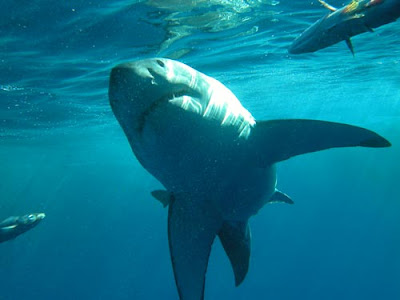Animal Unique | Great Whit Shark | GSW has a "torpedo shaped" body with a pointed snout. The belly of the shark is white (hence its name) but the top of the shark is actually grey making it hard to spot from above. "Average" size is around 3 1/2 to 5 meters long and weighing about 1,200kg with the females being larger than the males. They can have up to 3,000 teeth located in rows. Each tooth is saw toothed and triangular shaped. As a tooth is broken or lost it is replaced by a tooth from the next row, so the GWS always keeps a full mouth of teeth. The Great White Shark or sometimes called the "Great White" scientific name is Carcharodon carcharias.
There are over 600 species of Sharks and rays with the GWS (Great White Shark) belonging to a group of fast-swimming sharks called mackerel sharks GWS are usually solitary animals but have been seen in pairs and even occasionally in groups up to 7 or 8. Location of Great White Sharks The GWS is found in temperate (mild) waters fairly close to the shoreline They are found in most parts of the world including North & South America, Africa, Japan, China, Russia, New Zealand, and of course Australia
DIFFERENCE TO FISH
GWS are fish, but unlike most fish do not have bones but rather a "cartilaginous skeleton" 2 other differences are their scales which are not smooth and oily like most fish but very rough like glasspaper, and their gills (gill slits) which are not covered like most fish but are open. GWS are predatory (eats other animals fish etc) Their food includes other sharks, fish, sea lions, seals and other marine mammals, turtles, small whales. GWS are also scavengers eating animals already dead (Carrion) Despite having teeth GWS do not chew their food but swallow whole pieces ripped off their victim by their teeth
GWS are fish, but unlike most fish do not have bones but rather a "cartilaginous skeleton" 2 other differences are their scales which are not smooth and oily like most fish but very rough like glasspaper, and their gills (gill slits) which are not covered like most fish but are open. GWS are predatory (eats other animals fish etc) Their food includes other sharks, fish, sea lions, seals and other marine mammals, turtles, small whales. GWS are also scavengers eating animals already dead (Carrion) Despite having teeth GWS do not chew their food but swallow whole pieces ripped off their victim by their teeth
HUNTING
GWS swiftly attacks its prey from below taking a bite and letting the victim bleed to death. To locate its prey the GWS uses its very excellent sense of smell (especially of blood) and an ability to sense "electrical charges" given off by muscle movements. They sense these by their ampullae of Lorenzi, located in the pores around their snout. These are small tubes that pick up the information, and then send it to the brain.
GWS swiftly attacks its prey from below taking a bite and letting the victim bleed to death. To locate its prey the GWS uses its very excellent sense of smell (especially of blood) and an ability to sense "electrical charges" given off by muscle movements. They sense these by their ampullae of Lorenzi, located in the pores around their snout. These are small tubes that pick up the information, and then send it to the brain.
SWIMMING
These sharks use their tails to push them through the water and their fins to keep themselves balanced. They must constantly swim or else they will sink. The reason they would sink is, unlike bony fish (osteichthes), they do not have a swim bladder which holds air. The swim bladder in the bony fish can be controlled by valves. When the want to get more air in they open a certain valve, so they can rise. If they want to go lower in the water, they open another valve to let the air out. The air lets them float. The sharks do not have these, which is why they must keep swimming or they sink. GWS give birth to live young which are called pups. The pups fully develop inside their mother and once born they are immediately independent from their mother.
These sharks use their tails to push them through the water and their fins to keep themselves balanced. They must constantly swim or else they will sink. The reason they would sink is, unlike bony fish (osteichthes), they do not have a swim bladder which holds air. The swim bladder in the bony fish can be controlled by valves. When the want to get more air in they open a certain valve, so they can rise. If they want to go lower in the water, they open another valve to let the air out. The air lets them float. The sharks do not have these, which is why they must keep swimming or they sink. GWS give birth to live young which are called pups. The pups fully develop inside their mother and once born they are immediately independent from their mother.
Animal Discovery And Animal Unique In The World






Tidak ada komentar:
Posting Komentar